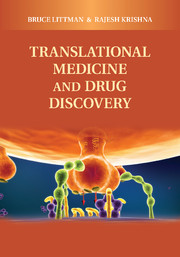Book contents
- Frontmatter
- Contents
- Contributors
- Preface
- Translational Medicine and Drug Discovery
- SECTION I TRANSLATIONAL MEDICINE: HISTORY, PRINCIPLES, AND APPLICATION IN DRUG DEVELOPMENT
- SECTION II BIOMARKERS AND PUBLIC–PRIVATE PARTNERSHIPS
- 8 BIOMARKER VALIDATION AND APPLICATION IN EARLY DRUG DEVELOPMENT: IDEA TO PROOF OF CONCEPT
- 9 IMAGING BIOMARKERS IN DRUG DEVELOPMENT: CASE STUDIES
- 10 EUROPEAN NEW SAFE AND INNOVATIVE MEDICINES INITIATIVES: HISTORY AND PROGRESS (THROUGH DECEMBER 2009)
- 11 CRITICAL PATH INSTITUTE AND THE PREDICTIVE SAFETY TESTING CONSORTIUM
- 12 THE BIOMARKERS CONSORTIUM: FACILITATING THE DEVELOPMENT AND QUALIFICATION OF NOVEL BIOMARKERS THROUGH A PRECOMPETITIVE PUBLIC–PRIVATE PARTNERSHIP
- SECTION III FUTURE DIRECTIONS
- Index
- References
9 - IMAGING BIOMARKERS IN DRUG DEVELOPMENT: CASE STUDIES
Published online by Cambridge University Press: 04 April 2011
- Frontmatter
- Contents
- Contributors
- Preface
- Translational Medicine and Drug Discovery
- SECTION I TRANSLATIONAL MEDICINE: HISTORY, PRINCIPLES, AND APPLICATION IN DRUG DEVELOPMENT
- SECTION II BIOMARKERS AND PUBLIC–PRIVATE PARTNERSHIPS
- 8 BIOMARKER VALIDATION AND APPLICATION IN EARLY DRUG DEVELOPMENT: IDEA TO PROOF OF CONCEPT
- 9 IMAGING BIOMARKERS IN DRUG DEVELOPMENT: CASE STUDIES
- 10 EUROPEAN NEW SAFE AND INNOVATIVE MEDICINES INITIATIVES: HISTORY AND PROGRESS (THROUGH DECEMBER 2009)
- 11 CRITICAL PATH INSTITUTE AND THE PREDICTIVE SAFETY TESTING CONSORTIUM
- 12 THE BIOMARKERS CONSORTIUM: FACILITATING THE DEVELOPMENT AND QUALIFICATION OF NOVEL BIOMARKERS THROUGH A PRECOMPETITIVE PUBLIC–PRIVATE PARTNERSHIP
- SECTION III FUTURE DIRECTIONS
- Index
- References
Summary
Introduction
The discovery and development of novel treatments is a lengthy and costly endeavor: for drug candidates entering clinical trials between 1989 and 2002, the estimated cost per new drug varied from approximately 500 million to more than 2 billion U.S. dollars. Biomarkers – objective and measurable responses to a putative drug candidate – have been heralded as one potential solution to the ever-increasing expenditure of developing new medicines, and anatomical or functional medical imaging can be one tool in the armamentarium of biomarkers. Conceptually, the utility of imaging biomarkers for facilitating drug development, especially go/no go decisions in early development, includes the following:
confirming the presence of a drug target in a (sub)population entering a clinical trial (e.g., accumulation of β-amyloid, as measured with positron emission tomography [PET] and a specific ligand for β-amyloid in the brain of patients entering a clinical trial for a novel Alzheimer's drug candidate);
assessing target engagement of a novel drug candidate (e.g., confirmation of dopamine-2 [D2]) receptor antagonism of antipsychotics using PET imaging of [C]-raclopride displacement);
demonstrating a functional effect of a drug on a mechanism- or disease-relevant biological parameter (e.g., blockade of ketamine-induced functional magnetic resonance imaging [fMRI] signal in the central nervous system [CNS] by antipsychotics or glutamate-normalizing compounds);
[…]
- Type
- Chapter
- Information
- Translational Medicine and Drug Discovery , pp. 222 - 264Publisher: Cambridge University PressPrint publication year: 2011



